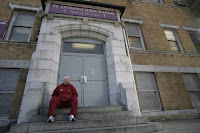- Henry Adams
This week a milestone in high school basketball will take place. In a small high school in a small New Jersey town, a coaching legend will join an elite group of coaches with 1,000 wins. Already enshrined in the Naismith Basketball Hall of Fame in Springfield, Massachusetts, this
 is yet another milestone for this remarkable coach.
is yet another milestone for this remarkable coach.I became aware of this story in a profile on CNN. Bob Hurley, Sr. is the head coach at St. Anthony High School where his illustrious coaching career began four decades ago. With 25 state parochial titles under his belt, his success speaks for itself.
Yet to comprehend what makes Bob Hurley such an extraordinary coach it is first important to understand what makes him such an inspiring person. And from his life story come leadership lessons that serve as an inspiration for any person desiring to make a difference in his business or organization. Apply these principles to your leadership and you too can be a Hall of Fame leader.
Embrace small beginnings with conviction. When Hurley began his coaching career it was not glamorous. Hurley would sweep the hardwood floors and ride to games in yellow school buses. Hurley’s humble beginnings were the foundation upon which he impacted the lives of hundreds of boys.
It is in the routine of small beginnings where the seeds of success are planted. It is in the fa
 ithful dedication to ones craft that those seeds mature and the fruit of ones labor is rewarded. It would seem that many would want to by-pass this all so important process, but not Hurley, and the lives he touched is the reward.
ithful dedication to ones craft that those seeds mature and the fruit of ones labor is rewarded. It would seem that many would want to by-pass this all so important process, but not Hurley, and the lives he touched is the reward.Serve great causes with purpose. While no one can deny Hurley’s success on the court, his most important contributions took place away from the game in the lives of inner-city boys he has impacted. Reflecting on all the games he has won, Hurley said, ‘You know what? I would give them up for one more chance with some of the kids I didn’t reach over the years. If I could have a second chance with some of those, it would be worth all the adulation.”
Hurley has dedicated his life to mentoring young boys at St. Anthony’s. He has impacted the lives of hundreds of players, many of whom now enjoy successful careers or like Terry Dehere, who went on to play in the NBA. "Hurley had a direct effect on a lot of young men’s lives growing up in Jersey City. To have a coach who was dedicated and a taskmaster helped a lot of kids – and I’m a living testament to it," says Dehere.
Consider any leader of distinction today and you will find this one characteristic to be a common thread. Each understand the value of serving causes greater than self and are committed to making the world a better place.
Reap great rewards. Out of the hundreds of inner-city teenagers Hurley coached, he has placed nearly all of them in colleges, and most of them on scholarships. The success he has enjoyed over the years on the court pales in comparison to the lives he has helped shape off the court.

Coach Mike Krzyzewski of Duke University was the presenter when Hurley was inducted into the Hall of Fame. Hurley’s son, Bobby, was a star point guard for the Blue Devils under Coach K when he won one of his four National Championships.
Speaking at the ceremony Coach Krzyzewski said, “Bob has a passion to help young men get the opportunities they would never have gotten unless he and basketball entered their lives. He should be in the Hall of Fame not for the number of wins, but for the number of lives he’s changed.”
Hurley has demonstrated throughout his career that sweeping floors is not beneath his pay grade; that serving causes greater than self is the greatest honor, and that changed lives is the ultimate reward for a coach. Hurley’s life and leadership is a resource for all present and inspiring leaders wanting to make a difference.
© 2011 Doug Dickerson












